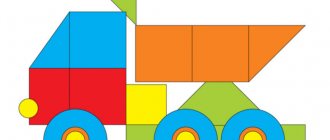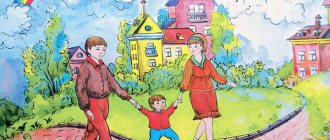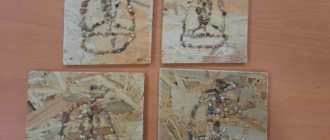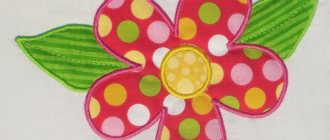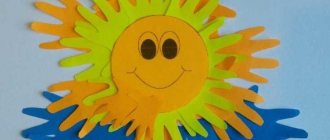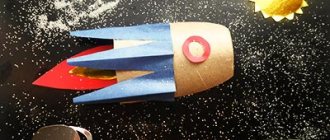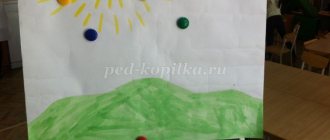Next riddle
Goal: To consolidate the ability to compose an image in parts from different figures.
Educational: learn to create images from different geometric shapes, consolidate the ability to compose an image from various parts
Educational: develop children's imagination and creativity, develop cognitive abilities.
Educational: to cultivate accuracy and perseverance.
Material: Envelopes with ready-made parts from which you can create images of objects familiar to children (house, carrot, ship, tumbler, traffic light, bell)
. Oilcloth, napkin, scissors, glue,
On the topic: methodological developments, presentations and notes
Summary of a lesson on FEMP in the middle group “Riddles for Thumbelina”
A fascinating summary of a lesson on FEMP for children of the middle group, including games to develop attention.
Outline of a lesson on applique, modeling (middle group) on the topic: Applique of disposable paper plates.
Application of disposable paper plates.
Lesson summary on appliqué for the middle group of kindergarten, lesson topic “Decorate a hat”
Systematization of preschool children’s basic knowledge about hats.
Summary of a lesson on application in the middle group (volume application) Prepared by the teacher of MBDOU d/c No. 3, Lebedyan Patutina Anna Alekseevna
Topic: "Dandelion". Program tasks: continue to teach children how to use scissors: hold them correctly, squeeze and unclench the rings, make cuts in a circle, cut a strip along the narrow side. Learn.
Summary of a lesson on application in the middle group “Riddle. The rocket is flying to the moon"
Subject. "Mystery. The rocket is flying to the moon” Goal: To carry out intellectual development through the inclusion of students in a variety of activities, in the conditions of integration of educational areas.
Summary of a lesson on applique in the middle group using non-traditional techniques (broken applique) on the topic: “Landscape “Spring””.
Summary of a lesson on appliqué in the middle group using non-traditional techniques (broken applique) on the topic: “Landscape “Spring””. Goal: Continue learning non-traditionally.
Summary of direct educational activities in the middle group on the topic “Chickens in the meadow” outline of a lesson on applique, modeling (middle group)
Introduce children to mixed media: applique from semolina, applique from waste material, painting. .
Preliminary work with children, discussion of the topic
Before moving on to the main part of the task, you should make sure that the children have a complete understanding of birds. To do this, you need to show them these animals live. If it is spring or summer at the time of the lesson, then you can go outside, because birds are especially active during this period. If it’s winter, when many birds go south, you have to be content with pictures or stuffed animals. You should also tell children about different types of birds, among which are:
- Migratory;
- wintering;
- domestic.
It is also necessary to talk about the diet of birds: mosquitoes and other insects, seeds and fruits. To captivate children even more, you can tell children fairy tales about these animals, ask them to guess riddles about birds, and also talk about interesting expressions like “small bird.”
Physical education minute
To prevent children from getting bored, physical education sessions must be held once an hour. If the room is large and spacious enough, then you can perform several dance moves to funny short songs.
Note! You can find songs about birds and invite children to perform flapping movements to the music, similar to flapping their wings. If the class is not very large, then you can do eye exercises.
Physical education for birds"
Next riddle
Strengthen children's ability to correlate flat geometric shapes with the shape of parts of objects, create an image from ready-made parts, and independently cut out small parts.
| The attachment | Size |
| konspekt_zanyatiya_po_applikatsii_v_sredney_gruppe.doc | 31.5 KB |
On the topic: methodological developments, presentations and notes
Summary of a speech therapy lesson for a teacher - speech therapist S. V. Turovskaya. Summary of the lesson "Sound "U""
Topic. Sound U. Purpose. Strengthen the skills of clear pronunciation of sound. Educational objectives: 1. Introduce children to sound.
Lesson notes in mathematics Lesson notes in mathematics in the middle group Topic: Plan (travel map) Program tasks: Develop the ability to navigate according to an elementary plan, correctly determine the relative position of objects in the
Lesson notes in mathematicsLesson notes in mathematics in the middle group Topic: Plan (travel map) Program objectives: Develop the ability to navigate according to an elementary plan, correctly.
Lesson notes Lessons on speech development Notes of the final lesson on speech development “Visiting grandma”
Lesson notesClasses on speech developmentLessons of the final lesson on speech development “Visiting grandma.”
Summary of an open lesson in a preparatory group for school Summary of an open lesson in a preparatory group for school Summary of a lesson in a preparatory group of a teacher-psychologist with hearing-impaired children
Date: February 21, 2012 Participants: children of the preparatory group Conducted by: educational psychologist Panova M.M. Purpose: to promote formation.
Notes for a comprehensive lesson in mathematics and design in the second junior group Notes for a comprehensive lesson in mathematics and design in the second junior group Notes for classes
Introduce children to number and figure 6. Improve counting skills and comparison of subject aggregates. Form children’s ability to distinguish between the concepts of yesterday, today, tomorrow. Consolidate knowledge about geome.
Lesson summary “Travel to Africa. How to help a boa constrictor? outline of a lesson in mathematics (preparatory group) on the topic outline of a lesson on the world around us (preparatory group)
Lesson summary “Travel to Africa. How to help a boa constrictor?” Program content: 1. Educational: learn to use a conventional measure when determining the size of objects.
1. Lesson notes on the surrounding world (01/11/2021) 2. Math lesson notes (01/13/2021) 3. Speech development notes (01/15/2021) 4. Drawing notes (01/19/2021)
1. The surrounding world Topic: Winter sports. 2. mathematics Schitariki-Smeshariki. topic: counting from 1 to 53. speech development, conversation with a puppet theater based on the fairy tale Rukavichka.4. drawing theme: Winter.
Questions for children based on their drawings
You should not finish the lesson immediately after drawing. Children should be encouraged to talk about what and why they drew. You can give the guys a little time to create a full-fledged history of their bird, give it a name, come up with a breed if one does not exist.
You can also ask the children whose bird is the most beautiful and why. But with this task you need to be very careful, because you cannot single out anyone, and you should not deprive them of attention. Some can be praised for their drawing technique and accuracy, some for their unusual story, and some for their successful combination of colors and realism.
This lesson will introduce children not only to a whole section of wildlife, but will also help develop their creative and social skills. For these reasons, art lessons should be taught as early as possible so that children from an early age are introduced to the broad concept of “beauty” and learn to work in a team.
Summary of the drawing lesson “Beautiful Bird” for children 4-5 years old
Lesson notes
«Beautiful bird»
for children of a general developmental group, aged 4 to 5 years
Date of:
Educational area:
Artistic and aesthetic development
Class:
Drawing
Priority:
Artistic and aesthetic development is integrated with physical development, social and communicative development, speech development, cognitive development.
Target:
development of children's creative abilities and interest in drawing.
Tasks:
Educational:
Teach children to draw a bird, conveying the shape of the body (oval), parts, beautiful plumage.
- Practice drawing with paints and a brush.
— Expand ideas about beauty, figurative ideas.
Educational:
— Develop figurative perception and imagination.
Educational:
— Foster a humane attitude towards the environment.
Preliminary work:
Observing birds while walking, looking at illustrations, sculpting birds. Examination of folk toys depicting birds.
Forms of work:
Individual, joint activities of the teacher with children, independent activities of children.
Methods:
Verbal:
questions for children, riddle.
Visual:
A sample of a drawn bird, a toy – a bird, a picture – a bullfinch.
Practical:
productive activity, physical education.
Types of children's activities:
gaming, communicative, motor, productive.
Individual work:
Offer a bird stencil.
Materials and equipment:
Demo material:
A sample of a drawn bird, a toy – a bird, a picture – a bullfinch.
Handout:
Colored pencils (colored wax crayons or felt-tip pens), paper 1/2 the size of a landscape sheet (for each child).
Motivation:
Progress of the lesson:
Introductory part
Motivational moment:
Educator:
Guys, what time of year is it now?
( children's answers
)
That's right, it's winter now. In the fall, we talked about migratory birds. They fly to warmer regions for the winter. And now we will talk about birds that remain for the winter. What are these birds called? ( children's answers
) What wintering birds do you know?
( children's answers
)
A bird should come to visit us, but first you must guess the riddle, what kind of bird is it?
Red-breasted, black-winged,
Loves to peck grains
With the first snow on the mountain ash
He will appear again.
What kind of bird is this? ( bullfinch
)
Educator:
That's right, it's a bullfinch. Look, the bullfinch has arrived.
Educator:
Bullfinch, why are you so sad? (whistles in the teacher’s ear that he has no friends) How can we help him?
( children's answers)
II. Main part
Educator:
The bullfinch got its name from the word snow, as it flies to our city with the first snow, lives all winter, and then flies off into the forest again.
This is a very beautiful and calm bird. She has a red breast, a small black head, a long tail, and a strong and thick beak. What do you think bullfinches eat? ( children's answers
) That's right, bullfinches eat tree seeds, cone seeds, and rowan berries.
This bird has a very weak voice. All you can hear is quiet whistling. But his song has many shades. With their whistle they can call friends or warn of danger.
Bullfinches are very friendly and always live in a flock. That's why our bullfinch wants a lot of friends
Let's look at a sample first. Look at the bullfinch.
What parts does a bird consist of? ( children's answers - torso
) What shape is it?
(oval)
What color?
( children's answers
)
What head? ( it's round, small and black
) The head is smaller than the body. It is located in front and slightly above.
What's on the head? ( eyes, beak
) Where does the torso end? (with his tail) What tail? (long and black)
We looked at the bullfinch. Now let's rest a little.
Physical education minute.
Paws get cold in the cold
At the pine and spruce.
(We are in a standing position, legs slightly to the sides, arms extended along the body and also slightly spread to the sides, palms parallel to the floor - we represent a spruce tree. We roll from our toes to our heels - we warm our “frozen” legs)
What kind of miracle? On the birch
The apples are ripe.
(We raise our heads up, pull our arms straight up, begin to jump high, as if trying to pick apples from a tree)
(We stop, lower our straight arms along the body)
I'll come closer to her -
And I can’t believe my eyes!
(We take a few steps forward, smoothly and slowly turn our heads alternately to the right and to the left - we “don’t believe our eyes”)
A flock of scarlet bullfinches
Stuck around the tree!
(making quick forward and backward movements with your “wing” palms laid back)
Educator:
You need to step back a little from the branch. And draw an oval and color it. I'm drawing a head. It is smaller than the body, located in front and slightly above. I draw a circle, paint it, draw a beak. On the other side I draw a tail. It is long and black. Two legs. On the body I draw an oval-shaped wing with a slightly pointed end. So the bullfinch is ready. And now you get to work.
Educator:
Guys, you helped our bullfinch. Look how happy he was. What a big and friendly family he has. Bullfinch says thank you!
III.Final part
Educator:
Guys, who came to visit us?
- Why did he come to us?
- How did we help the bullfinch?
— Did everything work out for you or did you have difficulties?
Now we will go outside and look at what birds fly to our site.
